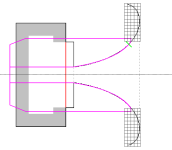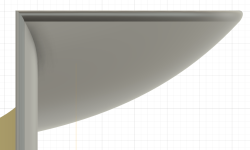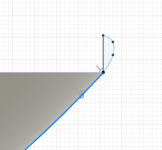I wanted parameters close to altec 416 and suitable for onken w, and same spirit (no overweight nor underweight moving mass and magnetic system etc). Plus as a bonus the lowest possible mechanical losses (Rms) I could find. Ended up with ciare pw388 (same: 15.64w). No flattering look, though.
I have been asked about diffraction off the top and bottom lips of the Yuichi A290, as treating these surfaces is reported to be an audible improvement. The vertical is the recipient of compromise in this horn due to it's smaller dimension and narrow but quickly widening profile.
The LeCleach profile is one whose gradually distributed diffraction makes it a good terminating profile. The Yuichi vertical is already in a state of rolling out, so it makes sense to try to continue that. This will have the positive effect of reducing diffraction over the smallest vertical space, but doesn't attend to the widening dispersion, for what that's worth.
IIRC, @Lynn Olson demonstrated how the LeCleach at T=0.7-0.8 is to be favoured for low reflection.
I have taken my vertical drawing from the original Yuichi plans and found a hornresp profile of T=0.75 to fit, and overlayed it here.

These are the horn parameters.

As can be seen, it wouldn't be too different to hanging radial baffle curtains below and above, for those who have considered that for simplicity.
The drawn grid is in centimetres. The green tick is approximately the 45 degree tangent point. The new overall dimension is roughly 45cm, so now comparable to the width.

The LeCleach profile is one whose gradually distributed diffraction makes it a good terminating profile. The Yuichi vertical is already in a state of rolling out, so it makes sense to try to continue that. This will have the positive effect of reducing diffraction over the smallest vertical space, but doesn't attend to the widening dispersion, for what that's worth.
IIRC, @Lynn Olson demonstrated how the LeCleach at T=0.7-0.8 is to be favoured for low reflection.
I have taken my vertical drawing from the original Yuichi plans and found a hornresp profile of T=0.75 to fit, and overlayed it here.

These are the horn parameters.
As can be seen, it wouldn't be too different to hanging radial baffle curtains below and above, for those who have considered that for simplicity.
The drawn grid is in centimetres. The green tick is approximately the 45 degree tangent point. The new overall dimension is roughly 45cm, so now comparable to the width.
What you suggest here is imo a huge integration waste of material with less effect on the performance.I have been asked about diffraction off the top and bottom lips of the Yuichi A290, as treating these surfaces is reported to be an audible improvement. The vertical is the recipient of compromise in this horn due to it's smaller dimension and narrow but quickly widening profile.
The LeCleach profile is one whose gradually distributed diffraction makes it a good terminating profile. The Yuichi vertical is already in a state of rolling out, so it makes sense to try to continue that. This will have the positive effect of reducing diffraction over the smallest vertical space, but doesn't attend to the widening dispersion, for what that's worth.
IIRC, @Lynn Olson demonstrated how the LeCleach at T=0.7-0.8 is to be favoured for low reflection.
I have taken my vertical drawing from the original Yuichi plans and found a hornresp profile of T=0.75 to fit, and overlayed it here.
View attachment 1180010
These are the horn parameters.
View attachment 1180012
As can be seen, it wouldn't be too different to hanging radial baffle curtains below and above, for those who have considered that for simplicity.
The drawn grid is in centimetres. The green tick is approximately the 45 degree tangent point. The new overall dimension is roughly 45cm, so now comparable to the width.
View attachment 1180014
Have you also taken into account what happens to the horizontal profile if you make the horn considerably longer as hrz and vrt profile are connected over the arc of the horn axis construction radius?
If I assume at the position of the green line is the end of the original profile then just add a tiny roll-over here and this is sufficient imo. Or you have to constantly increase the curvature up the the green line like a spiral.
Joseph Crowe has investigated acoustic benefits of the Le Cleach style continuous flare and published several designs and many thorough measurements and subjective evaluations of horns and he has concluded that he prefers a biradial horn over radially symmetrical horn. His flare is custom or proprietary, his ES profile. I think this is an efficient way to describe it since Le Cleach math is an iteration on top of conventional flare equations and any builder designing a profile is ultimately going to create something that cannot be described discretely by an equation. More so with a biradial design.
In any case his models and measurements could be useful, I believe his published measurements are documented well enough to draw your own conclusions.
https://josephcrowe.com/products/es-290-biradial-wood-horn
In any case his models and measurements could be useful, I believe his published measurements are documented well enough to draw your own conclusions.
https://josephcrowe.com/products/es-290-biradial-wood-horn
The radial style doesn't require that the sides be continued just because the top and bottom are.what happens to the horizontal profile if you make the horn considerably longer as hrz and vrt profile are connected
There are multiple issues to address, eg lower frequency support, vertical dispersion and/or simply a reduction in audible diffraction.
I didn't say how much of the continuation is needed to meet each of the goals. What do your numbers suggest?What you suggest here is imo a huge integration waste of material with less effect on the performance.
Unfortunately, I am afraid that it improves none of that. An infinite exponential horn with cut-off of 300Hz does not change it's cut-off when you truncate it. You need a minimum reasonable length or better exit angle which has been best described in Prof. Reicherts book when the termination exit angle is 90 degree: (Prof. Dr.-Ing. W. Reichardt zurückgegriffen: „Grundlagen der Elektroakustik“, Akademische Verlagsgesellschaft Geest & Portig K.-G., Leipzig, 3. Auflage 1960).Very nice! Probably also improve the LF limit, as well as time response.
So the Yuichi is already near the optimum exit angle with respect to the vertical and only needs a tiny round-over.
So the Yuichi is already near the optimum exit angle with respect to the vertical and only needs a tiny round-over.
Would this much round-over suffice in your opinion?
Attachments
Earlier in this thread g3dahl was quoted as having a ‘reference’ design for the ‘beyond’ - crossover is given but not plans/ photos.
I don’t think Gary is active here anymore…but is this the reference design he cooked up?
https://www.audio-talk.uk/phpBB2/viewtopic.php?p=114881&sid=ae77c84b06dcc681a903e8c9a00885b0#p114881

What’s the current state of play?
I don’t think Gary is active here anymore…but is this the reference design he cooked up?
https://www.audio-talk.uk/phpBB2/viewtopic.php?p=114881&sid=ae77c84b06dcc681a903e8c9a00885b0#p114881
What’s the current state of play?
Wow, I haven't been here for quite a few years, but the above photo is indeed of the speakers I built and still use today. It appears that this picture was taken after I had already replaced the TD15M's with the fabulous GPA 416-8B Classic Series alnico woofers. The system looks a bit different now, because later on I swapped out the original Radian compression drivers with Yamaha JA6681B's, along with their matching Azurahorns. Of course the crossover was reworked, and the prototype eventually replaced with one made from nice parts (Jupiter Condenser, etc.).
Gary, nice to hear from you and to hear that your speaker has been satisfying all this time. I participated a few times long ago in this thread and I am running a very similar setup.
If you dont mind I have a few questions, as you might still remember some details.
I remember reading you used fill generously (I might be mistaken, thou). Would you care to comment on that and if you did testing with different amounts/types?
In second place, you wrote that you got "matching Azurahorns" for for your CDs. Did you keep the front part of the driver on, i.e. did you use a horn with a 35mm diameter throat? You mentioned somewhere (I believe!) that you missed a little HF, but from you comment above it seems you didn't add the tweeter again.
Finally, Lynn mentioned not long ago he is building something similar and what caught my attention was that he mentioned that the small enclosure turned to have enough LF output in many rooms. Has this been your feeling too?
BR,
S.
If you dont mind I have a few questions, as you might still remember some details.
I remember reading you used fill generously (I might be mistaken, thou). Would you care to comment on that and if you did testing with different amounts/types?
In second place, you wrote that you got "matching Azurahorns" for for your CDs. Did you keep the front part of the driver on, i.e. did you use a horn with a 35mm diameter throat? You mentioned somewhere (I believe!) that you missed a little HF, but from you comment above it seems you didn't add the tweeter again.
Finally, Lynn mentioned not long ago he is building something similar and what caught my attention was that he mentioned that the small enclosure turned to have enough LF output in many rooms. Has this been your feeling too?
BR,
S.
Thom Mackris (Galibier Designs) and I are following in Gary Dahl's footsteps, with a 4.2 cubic foot closed box for the Altec/GPA 416 bass driver. The HF driver will be an Athos Audio Yuichi A290, with an adapter for 1.4" exit compression drivers.
The bass cabinet is 26" wide, has 4" radii on the left and right sides, and two internal shelves, partly visible in this photo. I have a pair of AH425 Azurahorns, as well as a pair of Athos Audio Yuichi A290 horns. The candidates for the 1.4" format compression driver include the RCF ND850 1.4, RCF ND950 1.4, Eighteensound ND3N, and the Faital Pro HF1460 carbon-fiber driver.
Crossover will be in the 700 to 800 Hz range, and the starting point will be a simple Altec N-800F/Heathkit AS-101 second-order crossover.



The bass cabinet is 26" wide, has 4" radii on the left and right sides, and two internal shelves, partly visible in this photo. I have a pair of AH425 Azurahorns, as well as a pair of Athos Audio Yuichi A290 horns. The candidates for the 1.4" format compression driver include the RCF ND850 1.4, RCF ND950 1.4, Eighteensound ND3N, and the Faital Pro HF1460 carbon-fiber driver.
Crossover will be in the 700 to 800 Hz range, and the starting point will be a simple Altec N-800F/Heathkit AS-101 second-order crossover.
Last edited:
Hi Swak, here are my responses to your questions:
1. I used Bonded Logic cotton batting for the stuffing. As with any sealed enclosure, the amounting of stuffing has a measurable impact on the Q. I made measurements with varying amounts of stuffing and saw the expected change. The enclosure is full of batting, but it isn't compressed, and there is a bit of space around the driver. I think the Bonded Logic product has been discontinued, sadly. I didn't try any other stuffing materials.
2. The Yamaha drivers are being used as designed; I did not remove the front part. This pair of AH-425 horns were made specifically for the JA6681b drivers, which I believe have a 35 mm exit. The RAAL ribbons have been left in place, but I don't always let them play. The system is intentionally voiced to be a bit soft on top, in order to make orchestral recordings sound as natural as possible.
3. I find the in-room bass response of the 416's in their sealed cabinets to be very satisfying without being augmented by the subs. At present, my subs are active only during home theater use.
What sort of setup are you using?
1. I used Bonded Logic cotton batting for the stuffing. As with any sealed enclosure, the amounting of stuffing has a measurable impact on the Q. I made measurements with varying amounts of stuffing and saw the expected change. The enclosure is full of batting, but it isn't compressed, and there is a bit of space around the driver. I think the Bonded Logic product has been discontinued, sadly. I didn't try any other stuffing materials.
2. The Yamaha drivers are being used as designed; I did not remove the front part. This pair of AH-425 horns were made specifically for the JA6681b drivers, which I believe have a 35 mm exit. The RAAL ribbons have been left in place, but I don't always let them play. The system is intentionally voiced to be a bit soft on top, in order to make orchestral recordings sound as natural as possible.
3. I find the in-room bass response of the 416's in their sealed cabinets to be very satisfying without being augmented by the subs. At present, my subs are active only during home theater use.
What sort of setup are you using?
- Home
- Loudspeakers
- Multi-Way
- Beyond the Ariel

